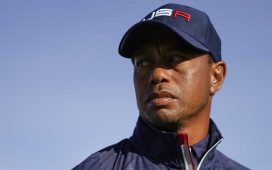Since the 1990s, Mike Davis has been one of the most influential people in golf. His increasing responsibilities at the U.S. Golf Association allowed him to shape the game at all levels, from the rules that govern the game to the setups that test the world’s best players to the amateur competitions available to the rest of us.
Davis announced Tuesday that he would be retiring from his role as USGA CEO, effective at the end of 2021. In light of that decision, Golfweek takes a look back at Davis’ rise through golf’s governing body, the forward movement he brought and the criticisms he faced.
1990
Davis, just 25 years old, was first hired by the USGA in April as assistant manager of Championship Relations. By the following December, he was promoted to manager of Championship Relations. He received another bump in October 1995, when he became the director of Championship Relations.
1997
Davis’ upward trajectory continued in the organization as he was promoted to U.S. Open Championship Director, a position which left him responsible for the day-to-day organizational activities for the U.S. Open.
2005
By taking on the role of senior director of Rules and Competitions, Davis also was charged with conducting the USGA’s 13 individual national championships and four team championships, as well as overseeing the Rules of Golf Department.
Most notably, Davis became the U.S. Open’s setup guy – a position that would ultimately make him a household name among golfers as he shaped the nation’s championship.
2006
Davis got right to work putting his stamp on the U.S. Open. At Winged Foot that year, the USGA debuted course setup changes that included graduated rough, day-to-day changes in hole lengths, and slightly wider fairways. They were met with mostly positive reviews from players.
In a 2012 Metropolitan Golf Association profile, Davis called the U.S. Open course setup gig “the one part of the job that I’d do for no pay.”
2011
When longtime executive director David Fay retired on Dec. 31, 2010 after his 32-year tenure with the USGA, Davis was chosen as the man to succeed him. Davis, 46 by then, became the senior staff member at the USGA, responsible for overseeing day-to-day functions right down to financial resources.
2012
Davis certainly fit the reserved, straitlaced USGA mold. But when “bird man” infamously charged through the 2012 U.S. Open trophy presentation at the Olympic Club, Davis didn’t hesitate in stepping in for the takedown. It was perhaps the most relatable, yet out-of-character, move of his USGA tenure.
Davis’ role in the top echelon of the USGA took him outside U.S. borders, too. As a member of the International Golf Federation, Davis played a role in selecting architect Gil Hanse to design the Olympic golf course in Rio de Janeiro for the 2016 Games.
2013
On Davis’ watch, the USGA announced that it would do something it had never done before: Retire a championship. The following year, the U.S. Amateur Public Links and U.S. Women’s Amateur Public Links were played for the final time and in 2015, they were replaced by the U.S. Amateur Four-Ball and U.S. Women’s Amateur Four-Ball.
John Bodenhamer, currently the senior managing director of championships, gave Davis much credit for the creation of the new events. Four-ball is a popular format at the state and regional level.
As Bodenhamer told Golf Digest in 2015: “These championships represent new thinking in the USGA. They were the visions of Mike Davis. He’s been advocating for this for about 15 years. When he took over, he brought it to us as the leadership.”
2016
Davis reached the highest rung on the USGA ladder when he became the first USGA CEO in the organization’s history. Thus he was the man to bare the brunt of all subsequent criticism.
That was heaped upon the USGA during the final round of the U.S. Open at Oakmont when a potential penalty for inadvertently moving his ball while standing over a 6-footer for par on the fifth green hung over Dustin Johnson’s head from the 12th tee, when officials approached Johnson after reviewing an instant replay, through the end of the round.
The potential penalty, which Johnson eventually incurred, clouded the final holes of the championship, causing the USGA to later issue a statement expressing regret at how the situation had been handled, though declaring the right decision eventually was made. Johnson still won the tournament.
Needless to say, the fiasco did not sit well with players and fans.
2018
When the U.S. Open was played at Shinnecock in 2004, a setup disaster made the seventh green all but unplayable. It was important for the USGA to get setup right in 2018. Instead, Davis & Co. found themselves in the middle of another debacle.
The course dried out by the afternoon of the third round and dramatic Saturday hole locations at Nos. 13 and 15 caused multiple players to comment that the USGA had “lost the golf course.”
Davis took arguably more heat that week than at any point in his career. He faced the media to offer an explanation and an apology for what he admitted was the USGA’s own setup error, one that had nothing to do with Shinnecock.
“There were some aspects today where well-executed shots were not rewarded. We missed it with the wind,” Davis said. “We don’t want that. The firmness was OK but it was too much with the wind we had. It was probably too tough this afternoon – a tale of two courses.”
The next month, the U.S. Senior Women’s Open made its debut at Chicago Golf Club. The USGA noted all week that it was a long overdue major, with Davis saying “It was really hard to look somebody in the face and say this is why we couldn’t do it.”
2019
Despite his well-known passion for U.S. Open course setup, Davis voluntarily stepped down from that role in January. Davis’ recent setups had been heartily criticized, from bumpy greens at Chambers Bay to fairways considered too wide and forgiving at Erin Hills to the recent nightmare at Shinnecock. The USGA noted that the decision had nothing to do with those Opens, but rather was a natural progression.
“This decision has been in the works for more than two U.S. Opens,” Davis told Golf Channel’s Jaime Diaz, who broke the story. “Whether people want to believe that or not, that’s for them to decide.”
Perhaps the bigger USGA headline of 2019 was the much-anticipated rules modernization, one intended to find common ground with everyday golfers by making the rules more practical and universally followed. That was widely considered a success.
2020
As Davis closes out his tenure with the USGA, the Distance Insights Project is something that will continue to work on in 2021 alongside the organization’s next leader.
The USGA and R&A, the game’s governing bodies, released their Distance Insights Report in February, a detailed document essentially stating that distance is playing an excessive role in the game and causing the sport to go in an unsustainable direction.
The project was put on hold later in the year as the USGA turned its attention to moving forward amid a pandemic.








